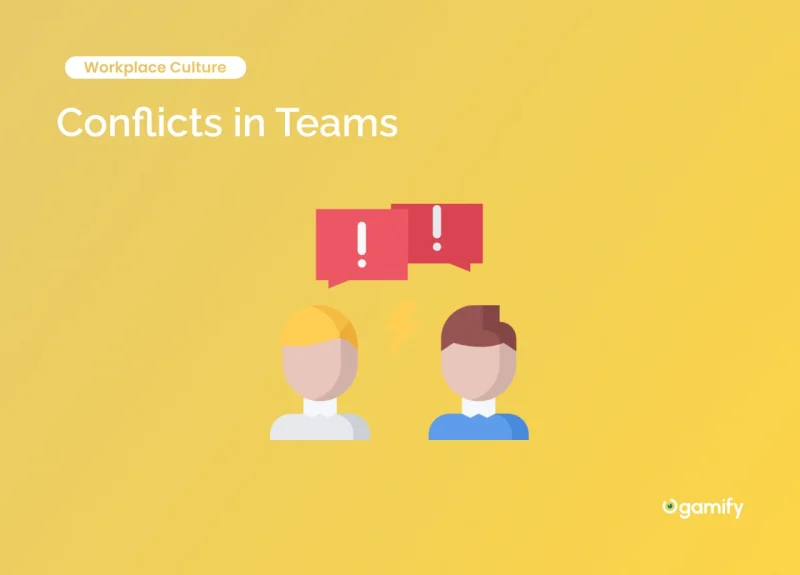Conflicts within a team are inevitable as individuals with different personalities, backgrounds, and work styles come together to achieve a common goal. However, unresolved conflicts can lead to decreased productivity, low morale, and even team dissolution. Therefore, team leaders and members must develop conflict management skills to handle conflicts effectively.
Understanding the root causes of conflicts in a team is the first step towards resolving them. Conflicts can arise due to differences in opinions, communication breakdowns, power struggles, or personality clashes. By identifying the underlying causes of conflicts; team members can address the issues at hand and find common ground to work towards a solution. Resolving conflicts in group requires effective communication, reflective listening, and empathy.

What Is the Basis for Most Team Conflicts?
Conflicts in a team are inevitable and can arise from various sources. However, a Harvard Business Review article states four triggers cause most team conflicts. These triggers are:
- Communication: Poor communication channels can lead to misunderstandings, missed deadlines, and unfulfilled expectations, resulting in team conflicts. Team members should establish clear communication channels and use them effectively to avoid conflicts.
- Task-based conflicts: These conflicts occur when team members rely on each other to complete a task or project. When one team member doesn’t meet their part of the task, it can affect another team member’s ability to finish their part on time. To avoid this type of conflict, team members should establish clear roles and responsibilities and hold each other accountable.
- Personality clashes: Different personalities and work styles can lead to conflicts in group. For example, an introverted team member may clash with an extroverted one who wants to brainstorm ideas out loud. To minimize this type of conflict, team members should learn to appreciate each other’s differences and work together to find regular ground.
- Values and beliefs: Conflicts can arise when team members have different values and beliefs. For example, a team member who values punctuality may clash with another who is more relaxed about deadlines. To avoid this type of conflict, team members should establish shared values and goals and work towards achieving them together.
Resolving conflicts in groups requires understanding and addressing the underlying causes effectively. By identifying the triggers that cause conflicts, team members can work together to prevent disputes from arising in the first place. Additionally, team members should develop strong communication skills, appreciate each other’s differences, and work towards common goals to minimize conflicts.

What Causes Conflicts in Teams?
Conflict is an inevitable part of working in a team. It arises when there are differences in opinions, priorities, or personalities. Conflicts can be caused by a variety of factors, including:
- Communication Differences: Communication breakdowns are a common cause of conflicts in groups. When team members have different communication styles, misunderstandings can arise, leading to disputes. For example, some team members prefer direct communication, while others prefer indirect contact.
- Opaque Performance Standards: When performance standards are unclear, team members may have different expectations about what is expected of them. This can lead to conflicts when team members feel that others are not pulling their weight or meeting expectations.
- Unreasonable Time Constraints: Conflicts can arise when team members are pressured to meet tight deadlines. Team members may feel that others are not doing their fair share of the work or working quickly enough.
- Personality Differences: Personality clashes can also cause conflicts in teams. Team members with different personalities may struggle to work together effectively. For example, some team members may be more assertive, while others may be more passive.
Team members need to understand what causes conflicts in teams so that they can work to prevent them. By identifying potential sources of conflict early on, team members can take steps to address them before they escalate.

Consequences of Unresolved Conflict
When conflicts in groups are left unresolved, they can have severe consequences for both the team and the organization. In fact, according to Forbes, turnover due to conflict is one of the most measurable costs for organizations. Some of the consequences of unresolved conflicts in teams include:
- Decreased productivity: When team members conflict, they may become distracted, disengaged, or even avoid working together. This can lead to missed deadlines, incomplete work, and decreased productivity.
- Low morale: Conflict in teams can create a toxic work environment, leading to low confidence, stress, and anxiety. This can have a ripple effect, causing other team members to disengage or even leave the organization.
- Increased absenteeism: When team members conflict, they may feel uncomfortable coming to work or take more sick days to avoid interacting with their colleagues.
- Negative impact on team culture: Unresolved conflicts can create a culture of fear, where team members are afraid to speak up or share their ideas. This can stifle innovation and creativity, leading to a stagnant team environment.
- Missed opportunities: When team members conflict, they may miss opportunities to work together or collaborate on projects. This can lead to missed opportunities for growth and development for both the team and the organization.
To avoid these consequences, it is important to address team conflict as soon as they arise. By doing so, team members can work together to find solutions and create a positive and productive work environment.

12 Tips to Unresolved Conflicts in a Team
When working in a team, conflicts are inevitable. However, it is essential to handle these conflicts constructively to ensure a productive and harmonious work environment. Here are 12 tips to help resolve conflict in groups:
Address the Conflict Early
When conflicts arise within a team, addressing them proactively and without delay is crucial. Neglecting a conflict can lead to its worsening and the deterioration of working relationships. Therefore, it is imperative to acknowledge and confront the conflict as soon as it emerges to prevent it from escalating further.
Listen Carefully
One of the critical steps in effectively resolving conflicts within a team is to listen attentively and empathetically to all parties involved. Allowing each individual to express their perspectives, concerns, and emotions without interruption or judgment is essential.
By actively engaging in attentive listening, team members can gain a deeper understanding of one another’s viewpoints, facilitating the identification of common ground and exploring mutually beneficial solutions.
Stay Calm and Objective
Maintaining composure and objectivity during the conflict resolution within a team is of utmost importance. By remaining calm and composed, individuals can minimize the influence of heightened emotions and personal biases, enabling them to approach the conflict with a clear and rational mindset.
This approach facilitates a more objective evaluation of the situation, enhancing the likelihood of finding a resolution that addresses the needs and interests of all parties involved.
Identify the Root Cause
Promoting open and transparent communication is vital in resolving conflicts within a team. Encouraging individuals to express their thoughts, concerns, and ideas openly facilitates sharing information, perspectives, and experiences.
This creates an environment of trust where everyone feels comfortable contributing to the resolution process. By fostering open communication, team members can collaboratively work towards finding a solution that satisfies the collective interests and values of the team.
Encourage Open Communication
Promoting open and transparent communication among team members is vital in resolving team conflict. Encouraging individuals to express their thoughts, concerns, and ideas openly facilitates sharing information, perspectives, and experiences.
This creates an environment of trust where everyone feels comfortable contributing to the resolution process. By fostering open communication, team members can collaboratively work towards finding a solution that satisfies the collective interests and values of the team.
Concentrate on Issues Rather Than Individuals
Focusing on the issues at hand is crucial during conflict resolution, rather than attributing blame to specific individuals. By separating the problem from personal identities, team members can prevent hatred and hostility from escalating further.
This approach ensures that the resolution process remains fair, impartial, and solution-oriented, emphasizing finding a collective agreement that addresses the underlying issues rather than personal attacks or judgments.
Brainstorm Solutions
Brainstorming potential solutions collectively with all parties involved is a valuable technique in resolving conflicts within a team. This inclusive approach encourages team members to contribute their insights and ideas freely, fostering a sense of ownership and engagement.
By engaging in collaborative solution brainstorming, diverse perspectives and creative alternatives can emerge which may not have been initially considered. This broadens the range of potential solutions, increasing the likelihood of finding a resolution that satisfies the team.
Be Willing to Compromise
In conflict resolution within a team, embracing the art of compromise is essential. Team members must be willing to let go of rigid positions and be open to finding a middle ground that accommodates all parties’ interests.
By demonstrating flexibility and adaptability, individuals can contribute to a constructive and cooperative atmosphere where mutually agreeable solutions can be reached. Emphasizing the spirit of compromise enables the team to move forward harmoniously, leaving behind the tensions and differences that initially caused the conflict.

Document the Agreed-upon Solutions
It is beneficial to document the agreed-upon solutions to solidify the resolution reached during the conflict resolution in teams process. This written record serves as a reference point for all team members, ensuring everyone is clear about their responsibilities and commitments moving forward.
Additionally, documenting the resolution helps prevent misunderstandings or disagreements in the future, as the agreed-upon terms are explicitly outlined and can be easily referred to if needed.
Follow Up
They are following up after the conflict resolution process is crucial to assess the implemented solution’s effectiveness and identify any emerging issues. Ongoing evaluation allows the team to monitor the progress in resolving the conflict and ensure that the solution works as intended.
By regularly checking in, team members can address any unforeseen challenges promptly, thereby preserving harmony within the team and avoiding the reemergence of conflicts.
Learn from the Conflict Experiences
Extracting valuable lessons from conflicts within a team is essential for preventing similar conflicting situations in the future. By reflecting on what caused the conflict and analyzing the underlying factors, team members can gain insights into the dynamics contributing to tension and disagreement.
Learning from these experiences empowers the team to develop strategies and practices that foster succesfull communication, collaboration, and conflict resolution strategies, thereby reducing the likelihood of future conflicts.
Seek Professional Help
In certain instances, conflicts within a team may prove challenging to resolve internally. In such cases, seeking professional assistance, such as mediation or counselling services, may be beneficial to facilitate the resolution process. Trained professionals can provide impartial guidance and facilitate constructive dialogue among team members. Their expertise in conflict resolution in teams techniques and strategies can help identify underlying issues and guide the team towards a mutually agreeable solution.
By following these tips, conflicts in a team can be resolved constructively and productively. This will help create a positive work environment and ensure everyone works towards a common goal.

Conclusion
Conflicts in teams are a common occurrence in the workplace. They can arise from various sources, including personality differences, power struggles, and communication breakdowns. However, it is essential to note that not all conflicts are harmful. Conflicts can sometimes be beneficial for teams, as they can lead to increased creativity and innovation.
To manage conflicts effectively, team members should first identify the types of conflicts they face. This can include task conflicts, relationship conflicts, or process conflicts. Once the kind of conflict within teams has been identified, members can work together to address the underlying issues and find a resolution.
Several strategies can be used to resolve team conflicts, including reflective listening, compromise, and negotiation. Team members must approach conflicts with an open mind and a willingness to understand the other person’s perspective.
Ultimately, conflicts in teams are a natural part of the workplace. While they can be challenging to manage, they can also provide opportunities for growth and development. By using effective conflict in teamwork resolution strategies and fostering a positive workplace culture, teams can overcome conflicts and succeed together.
FAQ
How can conflicts within a team be resolved effectively?
Resolving conflicts within a team requires effective communication, active listening, and a willingness to compromise. Team members should be encouraged to express their concerns and feelings respectfully. It is essential to identify the root cause of the conflict and work towards finding a mutually beneficial solution. In some cases, bringing in a neutral third party, such as a mediator, can help facilitate the resolution process.
What are some common strategies for resolving conflicts in a team?
Some common strategies for resolving conflict in teams include reflective listening, compromise, brainstorming, and negotiation. Team members need to remain respectful and open-minded during the conflict resolution process. Sometimes, taking a break and revisiting the issue may be necessary.
What are some key skills necessary for handling conflicts in a team?
Effective conflict in teamwork resolution requires strong conflict resolution skills, like active listening, empathy, and the ability to remain calm under pressure. It is also essential to identify and manage one’s emotions to avoid escalating the conflict.
How can mediation and compromise be used to resolve conflicts in teams?
Mediation and compromise can be practical tools for resolving conflicts in teams. Mediation involves bringing in a neutral third party to facilitate the resolution process. Compromise consists in finding a solution that is acceptable to all parties involved. Both mediation and compromise require mindful listening, open communication, and a willingness to find a mutually beneficial solution.
What are the steps involved in resolving conflicts between team members?
The steps involved in resolving conflicts between team members include identifying the issue, gathering information, clarifying the needs and concerns of all parties involved, brainstorming potential solutions, evaluating the answers, and implementing the chosen solution. All team members need to remain respectful and open-minded throughout the process.
What are some examples of successful conflict resolution in a team setting?
Successful conflict resolution in a team setting can take many forms. For example, team members may work together to identify the root cause of the conflict and find a mutually beneficial solution. Sometimes, team members may need to compromise to find a solution for everyone. Successful conflict resolution may also involve bringing in a neutral third party, such as a mediator, to help facilitate the resolution process.


